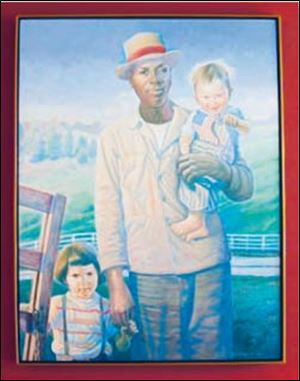
Wil Clay communicates with his art
2/22/2008
Wil Clay s painting, <i>Ed Clay American</i>.
With his expressive face and voice and natural storytelling ability, Wil Clay has entertained thousands of school kids for years.
He's reached many more with his skillful paint brush.
The 10th book he's illustrated, A Man for All Seasons: The Life of George Washington Carver, written by Stephen Krensky, will be published in April. And the nearly completed, 26-foot-long mural he's painting for the Mott Library aims to inspire the joy of reading for years to come.
Clay, who is selling his home near the Toledo Museum of Art to join his wife of eight months, Terry Clay, a high school bookkeeper, in Greenville, N.C., will give a free talk at 2 p.m. Sunday about storytelling and children's book illustration. As he often does, he'll also sketch a person from the audience.
The presentation and his art, including a rich, newly completed 40-by-60-inch portrait of a tobacco farmer, Ed Clay American, will be in the 20 North Gallery, 18 North St. Clair St. in downtown Toledo.
Born in 1938, Clay was one of five children, and grew up outside of Birmingham, Ala., drawing from the time he was a toddler.
"My mother, when I was 3. 4. 5, loved everything I did and she encouraged me. She would give me hugs and kisses and tell me it was good. She'd say 'Go back and do another.'•"
He copied the comics from the Sunday paper - Li'l Abner, Dick Tracy, the Phantom. He was inspired by Norman Rockwell and contemporary illustrators.
He didn't dare doodle during classes because his mother had advised his teachers to report to her if he did. But all along the way, his talent was recognized. In fifth grade, when he was placed with a group of students who were to make special drawings for the school, he realized he had found his calling.
"I thought, 'I'm going to be an artist. It makes people happy.'•"
After his parents divorced, his mother brought the four youngest children, including 12-year-old Wil, to Toledo where she remarried.
Thelma Shelton had graduated with a teaching degree but discovered she could earn better money as a seamstress than as a teacher. She developed an Ottawa Hills clientele. When Clay and his buddies formed their softball team they pretended it was a Cleveland Indians farm team and his mother sewed Indians logos on their shirts.
"It was a new world for me, moving from the segregated Alabama to Toledo."
He attended Macomber High School, Toledo's competitive vocational school, where watercolorist Ernest Spring took him under his wing, advising that if he learned to do hand lettering, he'd never go without a job.
He worked co-op jobs painting large signs for grocery stores and trucks. Fascinated by calligraphy, he studied from a book and practiced until he mastered it.
In 1956, he went on scholarship to the American Academy of Art in Chicago for less than a year before spending two years in the U.S. Navy. By the time he was discharged in Boston, he was married with two young children, so he bought a home in Providence, R.I., moved the family from Toledo, and attended art school.
After running a graphic arts business in Providence for six years, he moved to Corpus Christi, Texas, where he hoped to capitalize on growth in the oil industry.
"I figured there was enough work that they didn't care what color you were," he said. He was right, and designed logos, brochures, slide presentations for oil companies and fast-food restaurants.
By 1987 he was living in Houston and divorced for the second time, when his mother phoned and asked him if he'd come to Toledo to help her out; her husband was in a nursing home.
"By then, I had had enough of advertising and being stuck in traffic," he said.
Back in Toledo, his development as an independent artist began to fall into place. He rented a studio at the Common Space arts center on North Reynolds Road, and that's where a serendipitous meeting occurred.
Jan Wahl, who had been publishing children's books since 1964, was visiting an artist in another Common Space studio when he wandered into Clay's studio.
"I loved his painting immediately," said Wahl, of Sylvania. "I liked his slightly more abstract, more story-telling work."
Wahl was collaborating on a children's book based on an African-American folk tale named Tailypo, and liked what he saw so much, he broke a contract with his illustrator to hire Clay.
"I'm very pleased with the way Tailypo! worked out," said Wahl, who also collaborated with Clay on Little Eight John, winner of the 1993 Coretta Scott King book award for illustration.
In 1989, Clay created a six-foot bronze and stainless steel sculpture, four heads of Martin Luther King, Jr. mounted on a highly polished steel sphere and sited on the Martin Luther King, Jr., bridge downtown.
In 1990, he traveled to Cameroon, Africa, for three months to learn about and paint the Bamileke people of the south and the Fulani people of the north.
Clay continues doing school programs in selected states to promote reading.
Wil Clay will speak at 2 p.m. Sunday in 20 North Gallery, located at 18 N. St. Clair St. across from Fifth Third Field. The talk is free and open to the public. Information: 241-2400.
Contact Tahree Lane at:
tlane@theblade.com
or 419-724-6075.